

Haiku #XXX: by Xxx Xxxx
Published: XxxxxxxxxXxxxxxxxxxXxxxx 200X
Haiku #056: by Nathalie Buckland
Published: The Dreaming Collection 2007
Port Arthur
Between 1803 and 1853, about 70,000 convicts were deported to Van Dieman's Land, now the island state of Tasmania. About 12,000 of the 'worst criminals' went to the notorious prison of Port Arthur. Its ruins have been preserved.

The green rosella is endemic to Tasmania.

Haiku #201: by John Bird
First Published: Yellow Moon, 2001
Haiku #203: by Graham Nunn
First Published:
Haiku #204: by Lyn Reeves
First Published: Yellow Moon
Haiku #205: by Myron Lysenko
First Published:
Haiku #206: by Judith EP Johnson
First Published:
Haiku #208: by John Bird
First Published: The Dreaming Collection, 2008
Haiku #209: by Janice M Bostok
First Published: Amongst The Graffiti, Janice M. Bostok, 2003
Haiku #210: by Alma E Bird
First Published:
Lorikeet
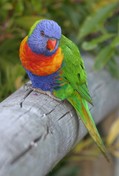 |
Rainbow Lorikeet Photos: K Vang and W Dabrowka / Bird Explorers © K Vang and W Dabrowka Image courtesy of the Australian Museum further reading: Birds in Backyards fact sheet |
Haiku #209: by John Bird
First Published:
Haiku #214: by Lorin Ford
Published: Haiku Harvest, Spring/Summer online 21/01/2006 and later in the year in the print edition. Published in The Dreaming Collection 2008
Irish Australians
Irish emigration to Australia began with the transportation of 40,000 Irish convicts. Many were deported for political activity such as participation in the Irish Rebellion of 1798. When convict transportation ceased in 1868 the inflow continued but as 'free settlers.' Today Irish Australians are the third largest ethnic group in Australia, after Australian and English.
Haiku #215: by Peter Macrow
First Published:
Haiku #216: by Jack Prewitt
First Published:
Haiku #217: by Cynthia Ludlow
First Published:
Haiku #223: by Katherine Samuelowicz
First Published:
Haiku #224: by Katherine Samuelowicz
First Published:
Haiku #225: by Lorin Ford
First Published: Frogpond, May 2006
Haiku #226: by Lorin Ford
First Published: The Heronís Nest, Volume VIII, Number 1: March, 2006
Haiku #227 by Janice M Bostok
First published Amongst The Graffiti, Janice M. Bostok, 2003
Emu (Dromaius novaehollandiae)
The Emu is a large flightless bird, 1.5 to 2 metres tall. It can run extremely fast. Emus feed on grass, leaves and small insects. They live all over Australia in grasslands.
further reading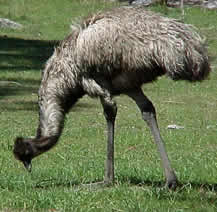
Image courtesy of and © Australian Fauna
Haiku #228: by Janice M Bostok
First Published: Poetry Australia No. 60, 1976
The Swamp Harrier, Circus approximans
native to Australia and New Zealand
Haiku # 56: by Jan Iwaszkiewicz
Published: The Dreaming Collection, 2008
Please use "Back" button to return to haiku.
Haiku #231: by Agniesza Niemira
First Published:
Haiku #233: by Andre Surridge
First Published:

Haiku #234: by Tony Beyer
First Published: the taste of nashi, New Zealand Haiku, by Windrift, Lower Hutt, New Zealand, 2008
Haiku #236: by Beverley George
First Published:
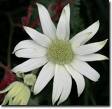
Flannel flower, a common name applied to several herbaceous plants of the Australian genus Actinotus.It grows in full sun or semi-shade and in harsh conditions
It is a short-lived perennial, living up to four years in its natural environment. They flower between in spring.
The best known species is the Sydney or Eastern Flannel Flower, A. helianthi, which ranges from the far south-east of NSW into
south Queensland, They are erect, up to a metre tall, with rather brittle stems and soft silver-grey leaves having a dense covering of pale woolly hairs.
Haiku #237: by Sandra Simpson
First Published:
Haiku #239: by John Knight
First Published:
Haiku #240: by John Knight
First Published:
Haiku #241: by
First Published:
Haiku #242: by Lorin Ford
First Published:
Haiku #243: by Alma E Bird
First Published:
Haiku #246: by John O'Connor
First Published:
Haiku #247: by Lorin Ford
First Published: an earlier version was published Shamrock Haiku Journal #7, Sept 08, before this version was published on Haiku Dreaming Australia
Haiku #250: by Bett Angel-Stawarz
First Published:
Haiku #: by
Whipbird
Eastern Whipbird Photo courtesy of Abberton Bird Lodge
Photographer: Bill Jolly. © Bill and Eileen Jolly
The whipbird is small, secretive and rarely seen in the thick undergrowth where it lives. But its dramatic call, a low note followed by a "whipcrack", is common in the bush.
Haiku #253: by Ashley Capes
First Published:
Haiku #254: by Maureen Sexton
First Published:
Haiku #253: by Ashley Capes
First Published:
Haiku #254: by Maureen Sexton
First Published:
Haiku #255: by Maureen Sexton
First Published:
Haiku #256: by Beverley George
First Published:
Ex-servicemen traditionally wear their medals on Anzac Day.
Medals of a deceased ex-serviceman may be worn by a relative.
Haiku #259: by Joanna Preston
First Published:
Haiku #260: by Timothy K
First Published:
Haiku #261: by Lorin Ford
First Published: The Heron's Nest, March 2007
Haiku #262: by Judith Johnson
Published: The Dreaming Collection 2008
Haiku #263: by Judith Johnson
Published: The Dreaming Collection 2008
Haiku #264: by Greg Piko
First Published:
Haiku #265: by Greg Piko
First Published:
Haiku #266: by Carla Sari
First Published:
Shearer
|
Shearers were the "characters" of the wool industry and shaped much of
Australia's 'bush' legacy. |

|
photograph: click to enlarge Image courtesy of © Australian Geographic |
The great shearer's strike of 1891-94 laid the foundations for the labour movement in Australia.
Shearers were hard men who worked intensely during the short shearing season (late winter), often under atrocious conditions. When the last shed was "cut out" (all the sheep shorn in the last shearing shed for the season) shearers were paid with a single cheque (check) for their season's work. Many shearers did not make it past the nearest town that had a pub; they stayed there until they had "cut out the cheque" (spent all their pay).
Haiku #267: by Carla Sari
First Published:
Haiku #268: by Carla Sari
First Published:
Shearer
|
Shearers were the "characters" of the wool industry and shaped much of
Australia's 'bush' legacy. |

|
photograph: click to enlarge Image courtesy of © Australian Geographic |
The great shearer's strike of 1891-94 laid the foundations for the labour movement in Australia.
Shearers were hard men who worked intensely during the short shearing season (late winter), often under atrocious conditions. When the last shed was "cut out" (all the sheep shorn in the last shearing shed for the season) shearers were paid with a single cheque (check) for their season's work. Many shearers did not make it past the nearest town that had a pub; they stayed there until they had "cut out the cheque" (spent all their pay).
Haiku #269: by Lorin Ford
First Published: Paper Wasp (Jack Stamm Awards), 2006
Haiku #270: by Lorin Ford
First Published: Yellow Moon 20, Dec 2006
Silvereyes (Zosterops lateralis)

a Silvereye on a Firewood Banksia
"The Silvereye is a small (9.5cm - 12cm) bird with a conspicuous ring of white feathers around the eye, and belongs to a group of birds collectively known as white-eyes." More pictures and information -- Australian Museum Fact Sheet
Wattle
Wattle ( Acacia pycnantha, Golden Wattle) is the national floral emblem of Australia.
1 September (the first day of spring) is officially 'National Wattle Day' but in most areas wattle blooms in late winter and is spoken of as 'the barbinger of spring'. Further reading
More than 900 species of Acacia make it the largest genus in the Australian flora.
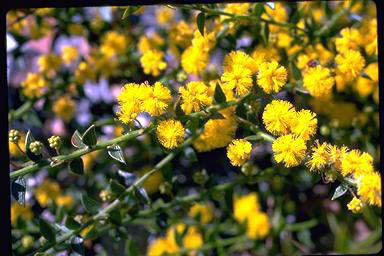
Acacia ambylgona
'Winter Gold'
Photographer: M Fagg
Image courtesy of and ©
Australian National Botanic Gardens
Haiku #274: by Nathalie Buckland
First Published: ?
Haiku #272: by Sue Stanford
First Published: The Dreaming Collection 2008
Morton Bay Fig (Ficus macrophylla)
A large evergreen banyan tree of the Moraceae family that is a native of most of the eastern coast of Australia. Its common name is derived from Moreton Bay in Queensland, Australia. It is best known for its beautiful buttress roots.

Ficus macrophylla is a strangler fig; seed germination usually takes place in the canopy of a host tree and the seedling lives as an epiphyte until its roots establish contact with the ground. It then enlarges and strangles its host, eventually becoming a freestanding tree in its own right. Individuals may reach 60 m (200 ft) in height.
It is widely used as a shade and feature tree in public parks and gardens, and wherever boys like to climb.Please use "Back" button to return to haiku.
Haiku #273: by Sue Stanford
First Published: The Dreaming Collection 2008
Entry for: Archibald Prize
"The Archibald Prize is regarded as the most important portraiture prize, and is the most prominent of all arts prizes, in Australia. It was first awarded in 1921 after a bequest from J F Archibald, the editor of The Bulletin who died in 1919. It is administered by the Trustees of the Art Gallery of New South Wales and awarded for 'the best portrait, preferentially of some man or woman distinguished in Art, Letters, Science or Politics...' " — Wikipedia
Please use "Back" button to return to haiku.
Haiku #274: by Doris Kasson
Published: and First prize 2006 Mainichi Daily News
BOOMERANG
Wikepedia: "A boomerang is a curved piece of wood used as a weapon and for sport. Boomerangs come in many shapes and sizes depending on their geographic or tribal origins and intended function. The most recognizable type is the returning boomerang, which is a throwing stick that travels in a elliptical path and returns to its point of origin when thrown correctly. Although non-returning boomerangs (throw sticks or kylies) were used as weapons, returning boomerangs have been used primarily for leisure or recreation."
Haiku #275: by Lorin Ford
First Published: Simply Haiku vol. 4 no.1,(USA) Spring 2006
Haiku #274: by Vanessa Proctor
First Published:
Haiku #277: by Lyn Reeves
First Published: Yellow Moon 2004
Haiku #278: by Lyn Reeves
First Published: paper wasp , 2003
Haiku #279: by Charlotte Trevella
First Published:
Haiku #280: by Quendryth Young
First Published: Yellow Moon No 18 Winter 2006; [The Whole Body Singing October 2007]
Haiku #: by Dawn Bruce
First Published: HaikuOz Bushfire Tribute, 11 Feb 09 http://www.haikuoz.org/
Haiku #274: by Ashley Capes
First Published: HaikuOz Bushfire Tribute, 11 Feb 09 http://www.haikuoz.org/
Haiku #283: by Matt Hetherington
First Published: HaikuOz Bushfire Tribute, 11 Feb 09 http://www.haikuoz.org/
Haiku #284: by Leonie Bingham
First Published: HaikuOz Bushfire Tribute, 11 Feb 09 http://www.haikuoz.org/
Haiku #285: by Ken Daley
First Published:
Two-up
Two-up was played extensively by Australia's soldiers during World War I and games, to which a blind eye was cast, became a regular part of ANZAC Day celebrations for returned soldiers.
In Two-up a designated 'Spinner' throws two coins, traditionally pennies, into the air. Players gamble on how the coins will fall.
Haiku #286: by Quemdryth Young
First Published: Kokako 7 September 2007; [The Whole Body Singing October 2007]
Haiku #287: by Linda Pilarski
First Published:

The Kangaroo moves by hopping on its powerful hind legs. It uses its thick long tail to balance its body while hopping. A kangaroo can hop at up to 60kmh (40mph). It can also leap over obstacles up to 3m (10ft) high.
Because of the unusual shape of its legs and its bulky tail, a kangaroo can't walk or move backwards very easily.
The kangaroo usually rests in the shade during the day and comes out to eat in the late afternoon and night when it is much cooler.
It eats mostly grass.
It needs very little water to survive. It can survive without drinking for months.
A kangaroo carries its baby in its pouch. The baby is born really tiny and crawls into its mother's pouch. The baby lives in its mother's pouch till it is quite large. Even when it is quite large it still drinks milk from a teat in its mother's pouch. It sometimes jumps into its mother's pouch head first when frightened. The kangaroo fights by attacking its opponents with its front paws (which have sharp claws) or by kicking them with its powerful hind legs.
Haiku #288: by Andrew West
First Published:
[details of 'tanami' later]
Haiku #289: by Andrew West
First Published:

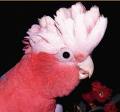
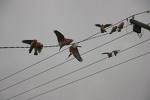
Haiku #290: by Marlene Ciampo
First Published:
Haiku #290: by Ken Daley
First Published: The Dreaming Collection, 2009
[details later]
Haiku #290: by Jack Prewitt
First Published:
Haiku #293: by Karen Phillips
First Published: The Dreaming Collection, 2009
Haiku #294: by Karen Phillips
First Published: Notes from the Gean Issue 2, 2009
Entry for: Wattle
Wattle ( Acacia pycnantha, Golden Wattle) is the national floral emblem of Australia.
1 September (the first day of spring) is officially 'National Wattle Day' but in most areas wattle blooms in late winter and is spoken of as 'the barbinger of spring'. Further reading

|
Acacia ambylgona 'Winter Gold' Photographer: M Fagg Image courtesy of and © Australian National Botanic Gardens |
More than 900 species of Acacia make it the largest genus in the Australian flora.
Haiku #290: by Vanessa Proctor
First Published: Haiku Hut/Short Stuff, February 2004
Haiku #296: by Quendryth Young
First Published: The Heron's Nest X No.4 December 2008
Haiku #297: by Greg Piko
First Published: paper wasp, 15(2), Autumn 2009

Haiku #290: by Greg Piko
First Published: Modern Haiku, Vol 40.1 (winter-spring 2009)
Haiku #290: by Kevin Gillam
First Published: the Gean Tree, 2009
Haiku #290: by Kevin Gillam
First Published: the Gean Tree, 2009
Haiku #290: by
First Published: